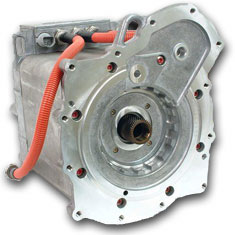

Ford Siemens, Electric Vehicle Motor
For the last few years, these motors have been selling on ebay for $1000 - $2000.Other than a few private parties here and there, Electro Mavin is the main supplier/seller.
What needs to be done to this motor to make it work as a traction motor for an electric car? I bought one, pulled it apart took some measurements and pictures.
Overview
This is a 3-phase water-cooled AC induction motor.There are 3 heavy gauge wires that go directly to the motor coils and a 6 pin connector going to a speed/position/temperature sensor.
Weight: 140lbs.
Markings from the manufacturer:
Type 1 PV5133-4WS20 W11
F8Y8-14B280-AC
33 KW / 67 Peak -- 42 HP / 90 Peak

The motor that I have does not include any of the gearing, just an open face with an output shaft and it still weighs 140 lbs.

The motor appears to have friction-free bearings and spins quite freely.





Some kind of an adaptor plate must be machined to bolt this to the trans-axle and the shaft must be modified all the mounting of a clutch plate.
Metric Mind sells controllers made by Siemens -- but, they are only sold with the motor. As far as I can tell, Metric Mind is selling new-old-stock Siemens products that are no longer in production.
Efforts to contact Siemens -- or find anything on the Siemens web site -- have turned up nothing.
Electro Automotive carries Azure Dynamics DMOC445 line of controllers. This controller might be the most cost effective means of controlling this motor. UPDATE (August 18, 2008) - I've decided to use Electro Automotive's AC Light Vehicle Manual Transmission kit for my Saturn conversion. The kit uses the Azure Dynamics AC24 3-phase motor and DMOC455 controller. This is my first conversion and there are simply too many unknowns to deal with. I wanted to use a motor and controller that is known to work together.
Since posting this page, I've been contacted by many people who either have this motor or are considering buying this motor. Based on correspondence with a few of these people and having learned a little bit more over the past few months I have some additional thoughts...
Application
The Ford Siemens motor is too big for a subcompact passenger car. It weighs 143 lbs and has a high end output of 90 HP. It's better suited for a small to larger pickup truck. For example: A Chevy S-10, Ford Ranger or possibly an F-150. My Saturn conversion will use the Azure Dynamics AC24 motor, which weighs in at less than 100 lbs and has a peak output of 58 HP. The Shaft
The output shaft of this motor is a gear. One way to deal with it is to weld a smaller shaft to the inside. Since this motor has a hollow output shaft you should be able to slip a shaft down the center and weld both ends.Possibly the best option is offered by Eric Tischer. He found an off the shelf taper lock from McMasterCarr that would allow a coupling or adapter to be bolted to the end of the shaft. This seems like the best way to deal with the gear teeth on the output shaft, you can see pictures of this on his page.
One final note: The bearing on the output side of the shaft is not sealed. This was done so that the gear box lubricant can lubricate the bearing. An equivalent sealed bearing must be used in its place.
The Controller
The controller is still the biggest unknown. I think that the Azure Dynamics DMOC445 or DMOC445LC (Liquid Cooled) is the best possibility -- however, some additional circuitry will be required to get the hall effect sensor signals from the Ford-Siemens converted to the balanced encoder signals required by the controller. Also, the Azure AC24 motor appears to have an indexing encoder output as well (1 pulse per revolution, I assume), this is not on the Ford Siemens motor -- but, could be simulated in the extra circuitry. It may not even be required, the DMOC is pretty configurable. |
Click here for a video demonstration of the Azure Dynamics DMOC445 3-phase ac motor controller and the Azure AC25 motor. While this video does not show the Ford Siemens motor in action is does demonstrate the Azure controller and regeneative braking. |
Here are some other controller ideas that came to my attention...
The Curtis 1238 is a 3-phase controller -- but, the maximum voltage is only 96 V, not enough to power the Ford-Siemens motor.
Eric Tischer has a web page that explains his promising attempts to use a low cost industrial 2-HP AC motor driver to drive a high current IGBT pack to drive this motor.
Cafe Electric, the developers of the Zilla controllers, is developing a 3-phase motor controller called Tri-Zilla. I don't know the specs and it's not yet on the market.
UPDATE (October 17, 2008) -Cafe Electric seems to be going through some serious restructuring in recent months. I have my reservations as to whether Zilla controllers will be made anymore. Please go to their site for the most recent information on this.
I've heard an unconfirmed rumor that AllTrax Inc. is developing a 3-phase controller and it's being tested on the Ford Siemens motor.
The Evisol EVI-200 (The Netherlands), looks promising too. It is not yet available and I don't have any pricing information.
Finally, if you have one of these motors and have decided that you want to sell it, please send me an email with your name, general location and price and I will post it on this page.